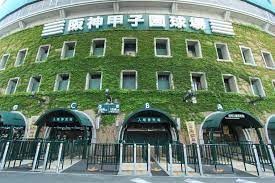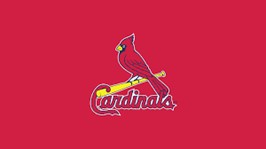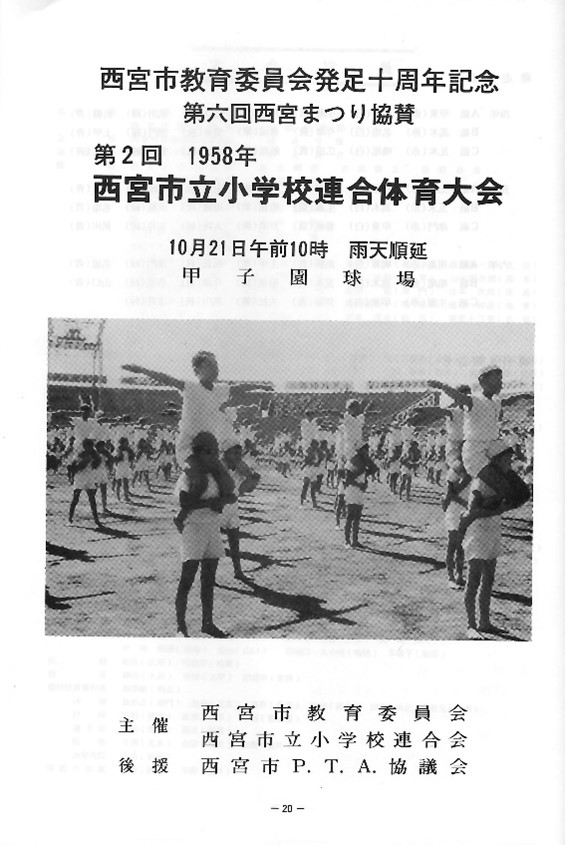| Hanshinkan Kid (8): @Koshien baseball stadium Memories of Koshien baseball stadium inspire Haruki Murakami |
||
| @@@ | ||
| On days when a baseball game is played at Hanshin Koshien Stadium in the city of Nishinomiya, Hyogo Prefecture,
Hanshin Electric Railway Co.fs Koshien Station continuously disgorges waves of people. As soon as they get off the train, many baseball fans rush to the stadium excitedly with ticket in hand. | ||
 @ @ |
||
| Hanshin Koshien Stadium | ||
| If you are one of those fans, as you near the ballpark, you see the stadiumfs high outside walls, which are traditionally
covered with ivy. As you enter the stadium through one of the dimly lit entrances and go up a flight of stairs, you find yourself in the stands,
amazed at the sharp, beautiful contrast between the dark, dirt infield and green grassy outfield. You are in the middle of a gsacred placeh for
Japanese baseball. Koshien Stadium, which was modeled after the old Polo Grounds in New York City, has given birth to many baseball legends in its 90-year history, hosts two national high school baseball tournaments every year, which are the focus of aspirations for high school ballplayers around the country. It is also the home stadium of the popular Hanshin Tigers professional baseball team. The word Hanshin here comes from Osaka and Kobe, just like the term gHanshinkanh area from between the two cities. Every time I visit this gsacredh ballpark, I feel exactly the same rush of excitement as when I made a trip to the place as a boy living in the city. I still live along the Hanshin railway line. With Osaka Bay located to the south of the stadium, the smell of the sea borne on a sea breeze often wafts into the bleachers, just as in those days. In Haruki Murakamifs novel gThe Wind-Up Bird Chronicle,h Major League Baseball's St. Louis Cardinals are mentioned in a scene where the narrator and protagonist recalls his baseball experiences as a boy. | ||
 @ @ |
||
| gWhen I was a kid, I used to like to sit up high in the outfield stands and watch the summer day trying not to end. ...
Small flocks of birds turning to their roosts would fly past toward the sea. This was the stadium at seven-thirty in the evening. I thought about
the baseball games I had seen over the years. The Saint Louis Cardinals had come to Japan once, when I was little, for a friendship game.h The name of the stadium is not mentioned in the novel, but when I read it the first time I immediately thought the stadium is modeled on Koshien, where Murakami spent his childhood years. | ||
 @ @ |
||
| Newspaper article of the friendship baseball game | ||
| In fact, the Cardinals played a game at Koshien in November 1958, when Murakami was a fourth-grader in the city. Murakami has also admitted that he would frequently go to the ballpark when he was a child. gWhile a high school tournament was held at Koshien, which was a short bicycle ride (from my house), I would go watch the games almost every day, h he said in an interview for the 2010 summer issue of gKangaeru Hito" (The Thinker), a quarterly magazine published by Shinchosha Publishing Co. I lived in the same city back then, and I also remember that I could travel to Koshien by bicycle in about 20 minutes. FROM HANSHIN FAN TO YAKULT FAN | ||
| In an open interview he gave in Kyoto on May 6, 2013, Murakami talked about how he switched from the Hanshin Tigers to the Tokyo
Yakult Swallows as his favorite baseball team. | ||
 @ @ |
||
| gWhen I was a kid, I would frequent Koshien and root for the Hanshin Tigers. After I later began to live near (Meiji)
Jingu Stadium (in Tokyo's Shinjuku Ward), I became a fan of the Yakult Swallows,h he was quoted as saying in the May 7, 2013, evening edition of The Asahi Shimbun. | ||
 @ @ |
||
| Murakami even became an honorary member of the Swallows fan club and urged other fans to go to the stadium and root for the team
in a statement published in the fan clubfs website on Sept. 1, 2013. In the statement, he also said, gWhen I was a child I lived in the Hanshinkan area and would go to Koshien to watch baseball games as often as I could. Inevitably, I became a member of the Hanshin Tigers supportersf association when I was an elementary school student (I would have been bullied at school if I hadnft).h This is apparently his attempt to explain why he switched allegiance from the Tigers to the Swallows. But it seems that the Swallows played a vital role in his life. In a collection of essays about running titled gWhat I Talk About When I Talk About Running,h Murakami describes how he decided to become a writer while watching a Swallows game at Jingu Stadium. | ||
 @ @ |
||
| gI can pinpoint the exact moment when I first thought I could write a novel. It was around one thirty in the afternoon of April 1,
1978. I was at Jingu Stadium that day,alone in the outfield drinking beer and watching the game.h It was the season opener, and the Swallows were taking on the Hiroshima Carp at home. In the bottom of the first inning, Dave Hilton, a young American player new to the team, hit a double to left in his first at bat in Japan. At that very moment, a thought struck Murakami: gYou know what? I could try writing a novel.h He doesnft know why, even now. He just had an epiphany in which he realized that he could write a novel. | ||
 @ @ |
||
| His baseball experiences are also reflected in one of the pieces in his latest collection of short stories,
gOnna no Inai Otokotachi" (Men without Women). One of the characters in the piece, titled gYesterday,h is a young man who was born and raised in Tokyo but speaks in the Kansai dialect. The man has been a devoted fan of the Hanshin Tigers since he was a child. He has worked hard to master the Kansai dialect because he wanted to be accepted by the community of Tigers fans from the Kansai region. When he went to watch Tigers games in Tokyo and rooted for the team in the cheering section, he was ignored by other Tigers supporters because he spoke in the Tokyo dialect (the standard language of Japan). This character is apparently a twisted reflection of Murakamifs own experience of becoming a Swallows fan despite having grown up as a Hanshinkan kid. This character, like Murakami himself, sticks to his convictions instead of simply accepting conventional ideas and common values, as indicated by his attitude toward baseball allegiance. SENSATIONS OF FEET TOUCHING THE GROUND AT KOSHIEN This yearfs National High School Baseball Championship, commonly known as gSummer Koshien,h is scheduled to start Aug. 11 at Koshien Stadium. The biggest dream of Japanese boys living for baseball is to play in the final tournament stage at Koshien as a member of one of the teams that have won regional tournaments to represent their prefectures. Both Yu Darvish and Masahiro Tanaka, two Japanese players now starring in the major leagues, once participated in the Koshien tournament, drawing much attention as star pitchers. But both Murakami and I, as Hanshinkan kids, have other kinds of boyhood memories about Koshien. In those days, all fourth- to sixth-graders in Nishinomiya took part in annual athletic meets organized jointly by all the elementary schools in the city and held in Koshien Stadium. | ||
 @ @ |
||
| The brochure of annual athletic meeting of all the elementary schools in the city | ||
| I remember well the joint athletic meet held in October of the year when the Cardinals played at Koshien. Along with many
other elementary school students of the same year in the city, I performed mass calisthenics barefooted. | ||
 @ @ |
||
| I felt awfully embarrassed while performing one part of the mass calisthenics in which we slouched and put our left hands
on our waists and swung our right arms in front of our bodies, mimicking elephants moving their trunks. Murakami, who was in the same school year as me, must have been there, performing the same dance. Both Murakami and I will probably never forget the sensations of our feet touching the little prickly grass and soft dirt on the baseball field. | ||
 @ @ |
||
| Ground of natural grass same as before | ||
Copyright Since 2009 OFFICE ATSURO KAWAUCHI. All rights reserved.